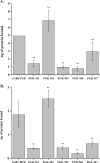Identification of the actin and plasminogen binding regions of group B streptococcal phosphoglycerate kinase
- PMID: 22761440
- PMCID: PMC3436549
- DOI: 10.1074/jbc.M112.361261
Identification of the actin and plasminogen binding regions of group B streptococcal phosphoglycerate kinase
Abstract
Phosphoglycerate kinase (PGK), present on the surface of group B streptococcus (GBS), has previously been demonstrated to bind the host proteins actin and plasminogen. The actin and plasminogen binding sites of GBS-PGK were identified using truncated GBS-PGK molecules, followed by peptide mapping. These experiments identified two actin and plasminogen binding sites located between amino acids 126-134 and 204-208 of the 398-amino acid-long GBS-PGK molecule. Substitution of the lysine residues within these regions with alanine resulted in significantly reduced binding to both actin and plasminogen. In addition, conversion of the glutamic acid residue at amino acid 133 to proline, the amino acid found at this position for the PGK protein of Streptococcus pneumoniae, also resulted in significantly reduced binding to actin and plasminogen. These results demonstrate that the lysine residues at amino acid positions 126, 127, 130, 204, and 208 along with the glutamic acid residue at amino acid position 133 are necessary for actin and plasminogen binding by GBS-PGK.
Figures






Similar articles
-
Binding of group B streptococcal phosphoglycerate kinase to plasminogen and actin.Microb Pathog. 2011 Oct;51(4):255-61. doi: 10.1016/j.micpath.2011.06.005. Epub 2011 Jun 28. Microb Pathog. 2011. PMID: 21729749
-
Phosphoglycerate kinase inhibits epithelial cell invasion by group B streptococci.Microb Pathog. 2005 May-Jun;38(5-6):189-200. doi: 10.1016/j.micpath.2005.02.002. Epub 2005 Apr 12. Microb Pathog. 2005. PMID: 15925270
-
Streptococcus pneumoniae phosphoglycerate kinase is a novel complement inhibitor affecting the membrane attack complex formation.J Biol Chem. 2014 Nov 21;289(47):32499-511. doi: 10.1074/jbc.M114.610212. Epub 2014 Oct 3. J Biol Chem. 2014. PMID: 25281746 Free PMC article.
-
Identification of genes affecting expression of phosphoglycerate kinase on the surface of group B streptococcus.Can J Microbiol. 2012 Apr;58(4):433-41. doi: 10.1139/w2012-015. Epub 2012 Mar 23. Can J Microbiol. 2012. PMID: 22444251
-
Phosphoglycerate kinase: structural aspects and functions, with special emphasis on the enzyme from Kinetoplastea.Open Biol. 2020 Nov;10(11):200302. doi: 10.1098/rsob.200302. Epub 2020 Nov 25. Open Biol. 2020. PMID: 33234025 Free PMC article. Review.
Cited by
-
Analysis of Paracoccidioides secreted proteins reveals fructose 1,6-bisphosphate aldolase as a plasminogen-binding protein.BMC Microbiol. 2015 Feb 27;15:53. doi: 10.1186/s12866-015-0393-9. BMC Microbiol. 2015. PMID: 25888027 Free PMC article.
-
A journey through the Corynebacterium pseudotuberculosis proteome promotes insights into its functional genome.PeerJ. 2021 Dec 23;9:e12456. doi: 10.7717/peerj.12456. eCollection 2021. PeerJ. 2021. PMID: 35036114 Free PMC article.
-
Starch Flocculation by the Sweet Potato Sour Liquid Is Mediated by the Adhesion of Lactic Acid Bacteria to Starch.Front Microbiol. 2017 Jul 25;8:1412. doi: 10.3389/fmicb.2017.01412. eCollection 2017. Front Microbiol. 2017. PMID: 28791000 Free PMC article.
-
Extracellular Vesicles Produced by Bifidobacterium longum Export Mucin-Binding Proteins.Appl Environ Microbiol. 2020 Sep 17;86(19):e01464-20. doi: 10.1128/AEM.01464-20. Print 2020 Sep 17. Appl Environ Microbiol. 2020. PMID: 32737132 Free PMC article.
-
Extracellular Actin Is a Receptor for Mycoplasma hyopneumoniae.Front Cell Infect Microbiol. 2018 Feb 27;8:54. doi: 10.3389/fcimb.2018.00054. eCollection 2018. Front Cell Infect Microbiol. 2018. PMID: 29535975 Free PMC article.
References
-
- Schuchat A., Robinson K., Wenger J. D., Harrison L. H., Farley M., Reingold A. L., Lefkowitz L., Perkins B. A. (1997) Bacterial meningitis in the United States in 1995. Active surveillance team. N. Engl. J. Med. 337, 970–976 - PubMed
-
- Weston E. J., Pondo T., Lewis M. M., Martell-Cleary P., Morin C., Jewell B., Daily P., Apostol M., Petit S., Farley M., Lynfield R., Reingold A., Hansen N. I., Stoll B. J., Shane A. J., Zell E., Schrag S. J. (2011) The burden of invasive early-onset neonatal sepsis in the United States, 2005–2008. Pediatr. Infect. Dis. J. 30, 937–941 - PMC - PubMed
-
- Edwards M. S., Baker C. J. (2005) Group B streptococcal infections in elderly adults. Clin. Infect. Dis. 41, 839–847 - PubMed
Publication types
MeSH terms
Substances
LinkOut - more resources
Full Text Sources
Molecular Biology Databases

